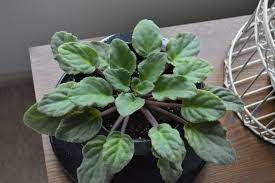African violets are beloved plants known for their vibrant and delicate blooms that add a touch of elegance to any indoor space. But it can be disheartening when your African violet fails to produce those charming flowers for you.
Several factors can contribute to the lack of flowering in these beautiful plants. Understanding these reasons is crucial for ensuring the optimal growth and blooming of your African violet.
In this blog post, we will explore the various causes behind the absence of flowers and provide practical solutions to help you revive your plant’s blooming potential.

8 Causes of African Violet Not Flowering
Too Little or Much Light
The amount of light African violets receives plays a significant role in their flowering. These plants thrive in bright, indirect light. Insufficient light can result in sparse or no blooms, while excessive light can cause wilting or burnt leaves.
African violets need about 12-14 hours of light each day, but direct sunlight should be avoided as it can scorch their leaves. Place your African violet near a north or east-facing window, or use fluorescent grow lights if natural light is limited. Rotate the plant occasionally to promote even growth and flowering.
Too Much Water
Overwatering can lead to root rot that prevents the African violet from blooming. These plants prefer slightly moist soil, but they are susceptible to waterlogging.
Poor drainage, improper watering techniques, or using the wrong type of potting mix can contribute to excessive moisture in the soil. These techniques will make your African violet, not flower.
Use pots with drainage holes and a well-draining potting mix specifically formulated for African violets. Allow the top inch of soil to dry out before watering again, and never let the plant sit in standing water.
Inadequate Water Supply
Underwatering can also hinder blooming in African violets. These plants have shallow root systems and rely on consistent moisture to thrive.
If the soil becomes too dry between waterings, the plant may go into survival mode, halting flower production. Regular watering is crucial, but be careful not to overdo it.
Water thoroughly, allowing the excess water to drain out of the pot, and empty any saucers to prevent water accumulation.
Inappropriate Fertilizer Application
Proper fertilization is essential for the healthy growth and blooming of African violets. But inappropriate fertilizer application can disrupt the delicate nutrient balance required for flowering.
Avoid using general-purpose fertilizers that may have a high nitrogen content, as they promote leafy growth at the expense of flowers. Instead, choose a balanced, water-soluble fertilizer specifically formulated for African violets.
Follow the instructions on the package for the correct dosage and frequency of application. Consider fertilizing once a month during the growing season is sufficient. Remember to water the plant before fertilizing to prevent root burn.
Inappropriate Pot or Container Size
The choice of pot or container can significantly impact the blooming of African violets. These plants prefer to be slightly root-bound, meaning they like a snug fit in their containers.
If the pot is too large, the excess soil can retain too much moisture, leading to root rot and hindered flowering. A pot that is too small restricts root growth and nutrient uptake.
Choose a pot that allows for about an inch of space around the root ball. When repotting, use a pot with drainage holes and a well-draining potting mix to ensure healthy root development and encourage blooming.
Extreme Indoor Temperature Variations
African violets are sensitive to temperature fluctuations and extreme variations can stress the plants, hindering their ability to bloom. These plants prefer a stable temperature range of 65-75°F (18-24°C).
Avoid placing them near drafts, open windows, or heat sources that can cause sudden temperature changes. These issues will prevent your indoor African violet plant from blooming.
Maintain a consistent temperature by closing windows during cold or hot weather and using curtains or blinds to regulate the amount of sunlight and heat entering the room. Providing adequate ventilation also helps maintain a stable indoor climate.
Low Indoor Humidity
African violets are native to tropical regions and thrive in moderate to high humidity. Insufficient humidity can cause the leaves to dry out, impacting the plant’s ability to bloom.
Indoor environments during winter months when heating systems are active, tend to have low humidity levels. Increase humidity around your African violet by using a humidifier, and grouping plants together to create a microclimate.
Another option is to place the plant on a tray filled with water and pebbles. The water in the tray evaporates, increasing the moisture in the air around the plant.
Plant Not Yet Mature
Young African violet plants may not flower until they reach a certain level of maturity. Exercise patience since it can take several months or even a year for a plant to mature enough to produce blooms.
Focus on providing optimal care, including proper lighting, watering, and fertilization, to support the plant’s overall health and development. As the plant matures, you will likely see signs of budding and eventual flowering.
Overgrown Plant With Suckers
An overgrown African violet with excessive suckers can divert energy away from flower production. Suckers are small side shoots that develop from the base of the plant or along the stems. (Source: Lowa State University).
If left unchecked, they can overcrowd the plant and limit blooming. Regularly inspect your African violet for suckers and remove them carefully using sterilized pruning shears or your fingers.
This redirects energy toward the main plant, promoting blooming. Pruning also helps maintain a compact and well-shaped plant.
Final Thoughts
The absence of flowers on your African violet can be attributed to various factors, including insufficient or excessive light, improper watering, inadequate nutrition, unsuitable containers, temperature fluctuations, low humidity, immaturity, or an overgrown plant.
By identifying the specific cause and implementing the appropriate solutions, you can revive your African violet’s flowering potential. Remember to provide optimal light conditions, maintain a balanced watering schedule, choose suitable containers, fertilize appropriately, and create a stable environment.
With patience, care, and attention, your African violet will reward you with a stunning display of blooms, bringing beauty and joy to your indoor space. Share your African violet not flowering experience with us in the comment section.
People Who Read This Also Read:
- African Violet Leaves Falling Off (Causes & Solutions)
- African Violet Leaves Drooping (Causes & Solutions)
- African Violet Leaves Curling (Causes & Solutions)
- African Violet Leaves Turning Yellow (Causes & Solutions)
- African Violet Leaves Turning Brown (Causes & Solutions)
- Brown Spots on African Violet Leaves (Causes & Solutions)
- How to Care for African Violets Indoors






